| |
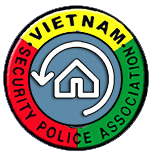 |
Vietnam
Journey to Tân Mỹ Air Field
LORAN Tower
366th Security
Police Squadron,
"Det. 1, 366th SPS"!
September 02, 1972
by Mike J. Douglas - ASRX
DN, 366th SPS, DET 1/TMY
1971-1972
© 2006
 |
 |
|
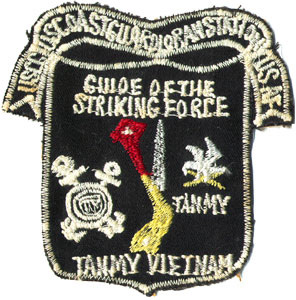
Unit patch for Detachment 1, 366th SPS - Tân Mỹ, Vietnam: USCG-US Coast
Guard Loran Station - USAF. "Guide of the Striking Force" TAN MY, VIET NAM.
|
| A Tân Mỹ Story |
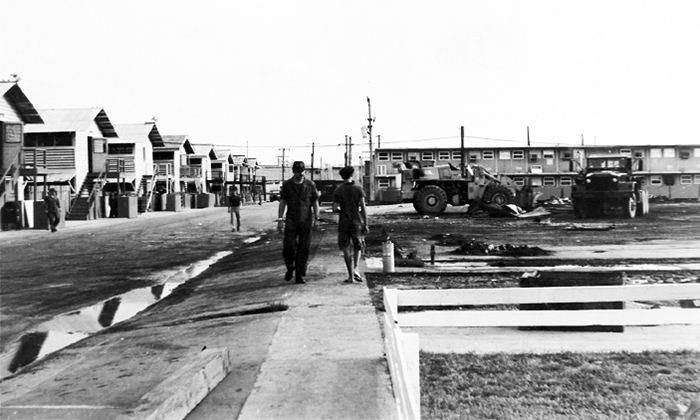 |
My journey to Tân Mỹ started about a month and a half after I landed at Da Nang on August 13th, 1971. Da Nang was supposed to be my home for the next 365 days, but that changed when, without going into too many details, I found myself facing an Article 132 court martial, much to my chagrin. I didn’t agree with that decision and got a lawyer. He was able to convince the CO that there was no merit to this punitive action, and the charges were dropped -- and I was labeled as trouble.
The Major gave me two choices: I could go to the K-9 section at Da Nang or get shipped north to an isolated detachment called Tân Mỹ, located near the DMZ. After quickly weighing my options, I figured Tân Mỹ might be a better deal as the October rains were then upon us, and felt I might be able to stay a little dryer at Tân Mỹ.
Two days later, I was on my way to Tân Mỹ. I met a jeep mounted with twin M60’s at the orderly room, and loaded up for the drive. The 60’s reassured me a bit, although the metal trailer weighed down with gear and supplies made me think we weren’t going to be overly nimble.
One vivid memory of the trip north was passing the giant white statues of Buddha. These statues must have been 7-8 stories high (just a guess) and could be seen from miles. As we continued north, we headed for the Hai Van pass picking up altitude along the way. By then we were in a convoy of Honda motorcycles, 3-wheel cyclos, small trucks overloaded to the max with humanity of all kinds as well as clucking chickens in wooden cages, and Shell Oil fuel trucks.
At one point, the convoy came to a halt and within a minute, we began to hear small arms and automatic weapons fire all around us. On one side of the road was a mountain, as steep and rugged as you can imagine, with a million places for someone to hide. On the other, was a steep drop-off into the valley below.
We decided to the best course of action at that point was to unass the jeep, and lay on the downside slope, to try to get a fix on the incoming fire. It was very difficult to spot any smoke or anything for that matter. Of course, it was made harder by the fact that we were becoming one with the terrain underneath us. After about 10 minutes, the rounds stopped, the convoy started on its slow pace again, and I breathed a sigh of relief. But I was starting to think I’d made a really bad choice.
As we descended out of the mountains, the view was spectacular. We traveled on a road that seemed to hug the coast at times, while winding through beautiful little seaside villages and hamlets. The entire region was much more rural than in the Da Nang area. After several hours we began seeing increased military activity in the form of never-ending Army convoys heading south along the highway.
Soon we came upon the massive red mud complex of Phu Bai, a giant US Army post cut out of the jungle. There didn’t seem to be much other civilian life around, but the post itself seemed as large as a small city, with troops, deuce and a half’s, and Hueys’ moving around at a frenetic pace.
Phu Bai was about an hour from our destination of Tân Mỹ. We drove through the old Imperial Capital of Vietnam, the ancient city of Hue. It was in fact very beautiful, bustling with activity and situated on the Perfume River. But evidence of the 1968 Tet Offensive was everywhere, visible in the damaged buildings and vehicles disabled where they were hit. |
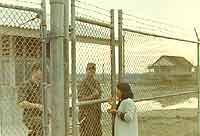
A1C Max Stewart on duty at one of the base gates.
I believe Max is a member of VSPA Tân Mỹ was only about 10 miles north of Hue, at the dead end of a road that extended the length of a small peninsula. The flat coastal terrain with just a few palm trees was a change from the jungle and mountains of the Da Nang area. The base itself existed only to man and protect the 625’ Loran Tower, set on the end of the road. |
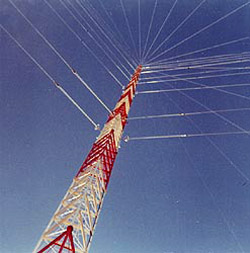
I got my first glimpse of the tower maybe from about a mile away, it was that tall. The purpose of this tower, to my understanding was to provide a signal for the B-52’s and the F-4’s and F-105’s flying missions in I-Corps as well as north of the DMZ. The US Coast Guard provided the electronics and communications side of the tower while the USAF Security Police provided security for the entire installation.
The base itself was quite small. Picture a 625’ tower with the acCOing steel cable guide wires anchored 360 degrees around it to keep it standing. What you had was one big circle, with a perimeter about a mile in circumference. |
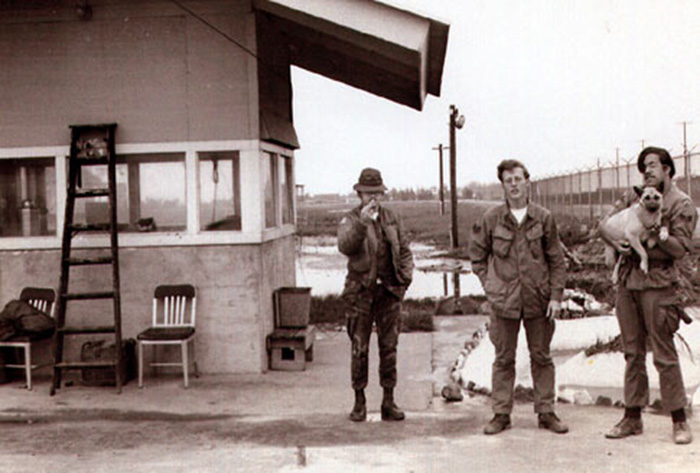 |
Tân Mỹ, Vietnam 1971-1972:
Front gate of the small base, with A1C Rossovich, Sgt Mike Banks and Sgt Brown mugging for the camera. Brown is holding the unit dog, Ralph.
Front gate which doubled as our CSC.
There was a small one lane paved road around the guide wires, and from there it was maybe 40 yards to the fenceline, which was protected by 3 huge towers, 2 bunkers and a front gate which doubled as our CSC.
This small little outpost would be my new home for the seven months. The whole place was quite informal, with approximately 30 Coast Guard personnel, and about the same number of Security troops. The highest-ranking Air Force troop was a Tech Sgt followed by two Staff Sgt’s and the rest were Airman First Class and buck Sergeant’s. |
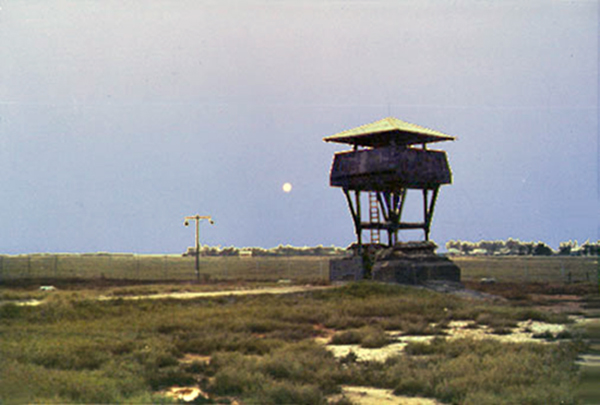
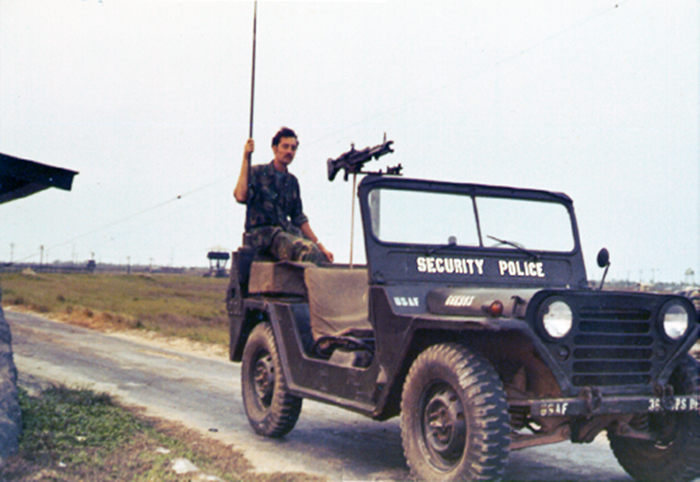
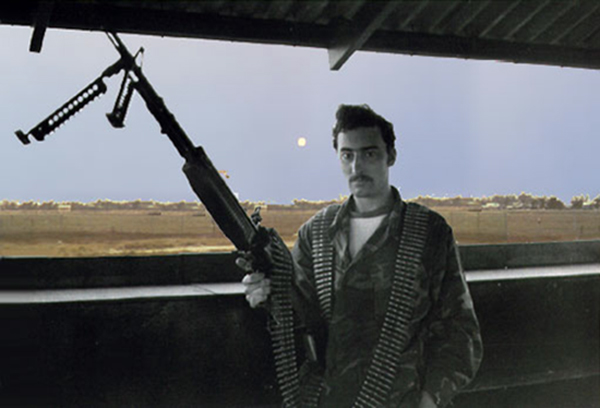 |
| Sunset in Tân Mỹ with one of our three towers in the foreground. Days turned into weeks as routine set in. There was no guardmount as such, you would merely stop by the guard shack and let them know you were gonna head for your tower or bunker for the night. You gave them a radio check when you got there, and the night was pretty much yours and you did what you could to stay warm, dry and alert. |
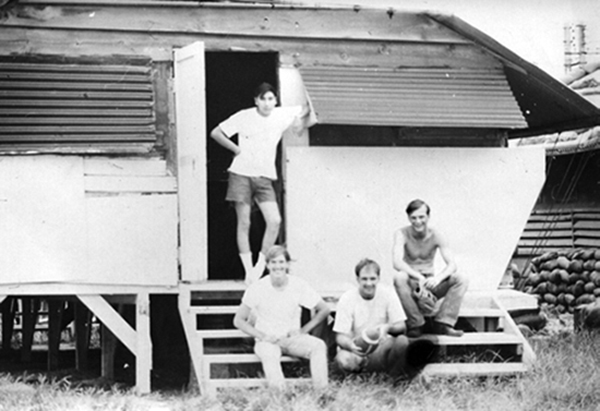

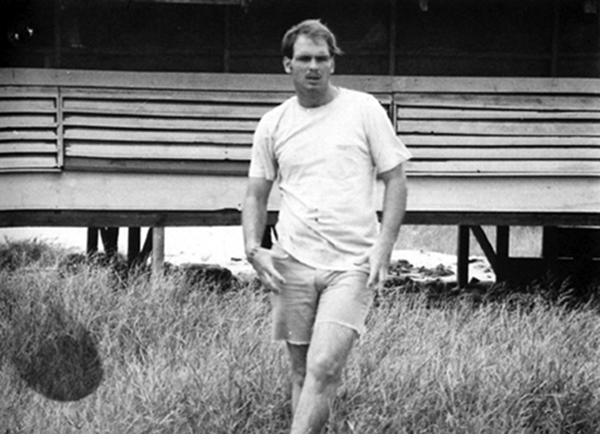
|
When dawn finally arrived you headed for bed, and were happy to do so, as the accommodations were first rate, all in all. We lived in small partitioned trailers, with two men to a room. We could actually stay dry and relatively warm while sleeping, unlike the night pulling guard duty.
The fact that this was a combined Coast Guard/Air Force operation provided many perks for us. The Coast Guard was quite proud of their men in Vietnam; I believe other than a very few troops in the Saigon area, they had a minimal presence in country. Bottom line was they really took care of their troops and us as well. The chow was as good as anything you’d get in the ‘Nam, and believe me, we knew how good we had it. |
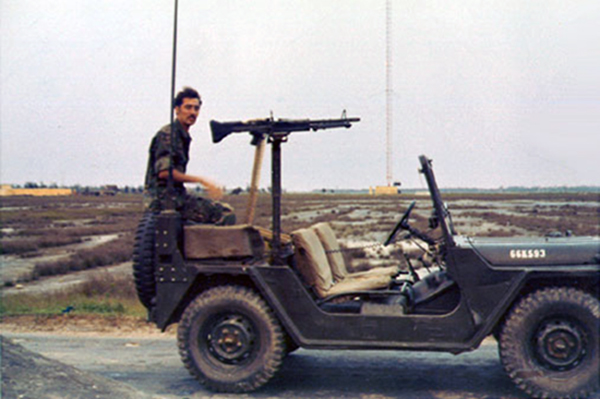
Sgt Mike Douglas in the back of a jeep
with the Tân Mỹ Tower in the background.
Life was pretty routine, the same schedule day after day, so imagine our surprise when we were told we could drive to Phu Bai to take in the Bob Hope Show on Christmas Day 1971. We had pulled duty all night, but were running on adrenaline (and by the time we got to Phu Bai, a few beers) and were happy for this change in routine.
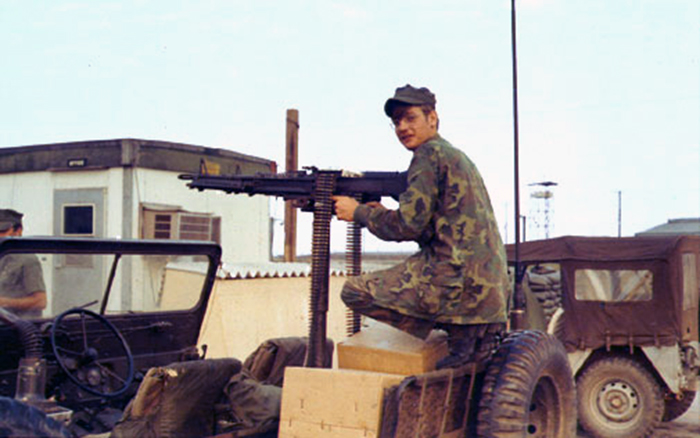
A1C Mike Thomas, riding shotgun, getting ready to leave base for a trip to Da Nang, 1972.
We sat for hours waiting for the show to start, and the wait was worth it, when Bob Hope came out with Ann Margaret and her dance troupe, Les Brown and his band of Renown and other performers and singers. They put on a hell of a show, and we were very grateful, as we knew they didn’t have to be there--they could have been home with their families.
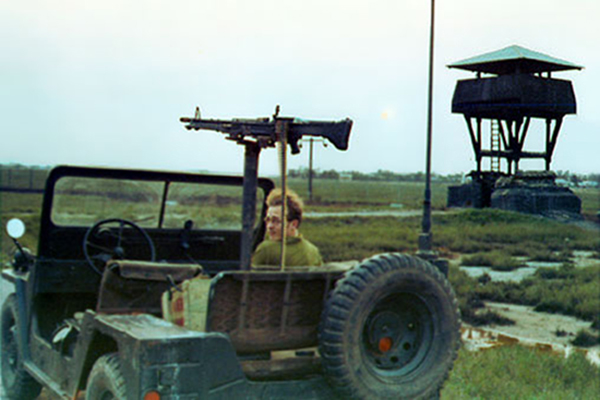
Sgt Mike Banks in a jeep
near Tower 3 at Tân Mỹ, Vietnam.
As January arrived, we started hearing rumblings of the potential for trouble as Tet neared. Intelligence predicted trouble all through I Corp. So we now pulled our duty at night, and then filled sandbags and set trip flares and claymores till lunchtime, after which we could go to bed.
While the base was already secured with the above mentioned, everyone agreed you couldn’t have too much help, in the event of trouble, especially when our base was only 28 miles (at least that’s what we were told) from the DMZ.
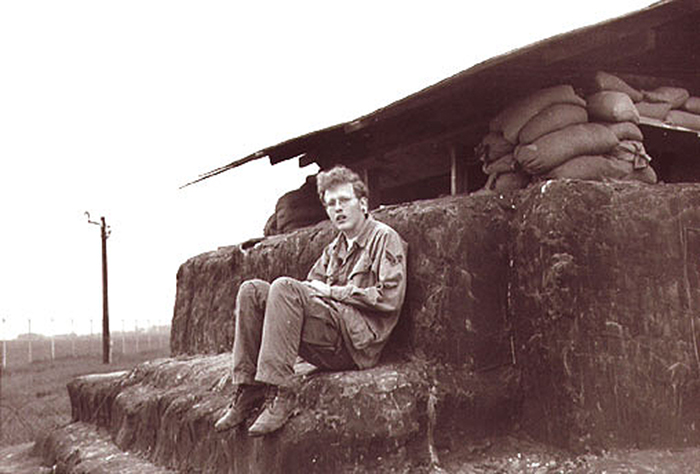
Sgt Mike Banks takes a break sitting on bunker #2 at Tân Mỹ, Vietnam - 1972
Tet came, and the VC did invade the South, crossing the DMZ and wreaking havoc throughout I Corp. At one point, we received additional help in the form of about 60 additional infantry troops from the 101st Airborne, who were dropped by Hueys inside our compound one afternoon. They stayed with us for ten days helping secure the base, until the threat died down.
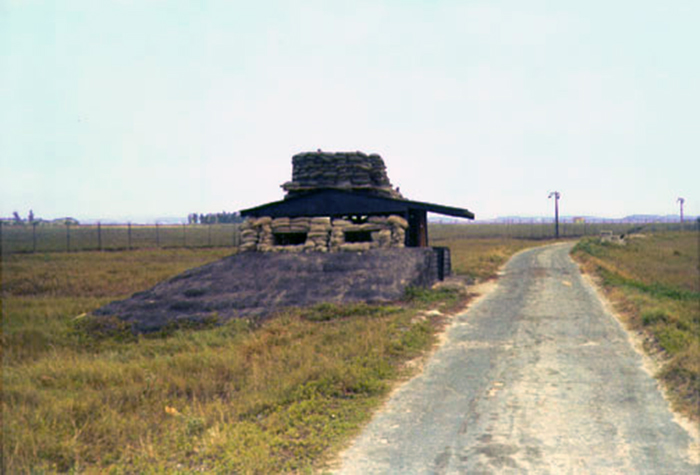
Bunker #2, on the perimeter at Tân Mỹ, Vietnam
1971-1972.
The attack we expected never materialized, but we woke up one day to see a captured Russian tank that had been disabled by air support across the street from our base. The 101st also lost a man when a claymore detonated on his person while in our compound. His friends thought he’d just come from out in the field, and failed to take the cap out of the claymore before he put it in his pack.
|
| |
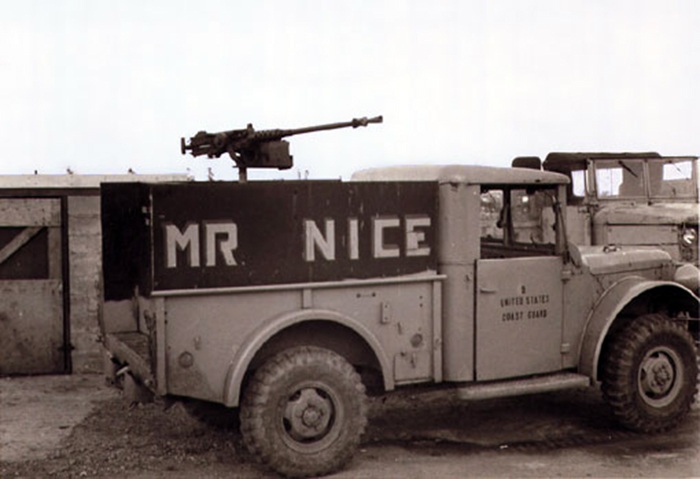 The only US Coast Guard gun truck in Vietnam. The Coast Guard performed maintenance on the 600' LORAN tower in
Tân Mỹ, while the USAF Security Police forces provided security for the site. The only US Coast Guard gun truck in Vietnam. The Coast Guard performed maintenance on the 600' LORAN tower in
Tân Mỹ, while the USAF Security Police forces provided security for the site.
Things soon settled down and routine set in again. Other than an occasional trip flare going off, and keeping an eye on suspicious sampans that remained near our shore longer than we felt comfortable with, things were pretty quiet. Our fence line was cut one night, and the trip flares triggered, but never lite-up what we thought were potential sappers. We did however, light up the sky up for the rest of the night, using more than one or two cases of slap flares. Daylight inspection showed that someone had breached our line, but apparently left quickly amidst our ensuing reaction. By and large the duty was good in Tân Mỹ, with good hot chow, warm showers and a dry place to sleep.
We got to be pretty good friends with the Coast Guard guys, and took turns taking each other’s money every payday with crap games and poker.
Our NCOIC MSgt Raymond L. Osborne ventured up from Da Nang to spend a couple of days every month or so, and was a good friend to the troops, loved and respected by all.
We ventured out to Phu Bai on mail runs or to Da Nang for supply runs, but stayed close to home most of the time. Spring turned into summer, and like every GI in Nam, we counted our days.
I headed back to Da Nang for my last few months and soon missed Tân Mỹ when the rockets came in earnest as they did at Rocket City. By the end of my tour we were even getting rockets during the day, which hadn’t happened before, during my prior stay there. I was offered an early out if I extended for 6 months, but felt it was my time to leave. After a total of 30 months in the Far East, first in Okinawa and then in Vietnam... it was time to go home. |
| |
|
|

